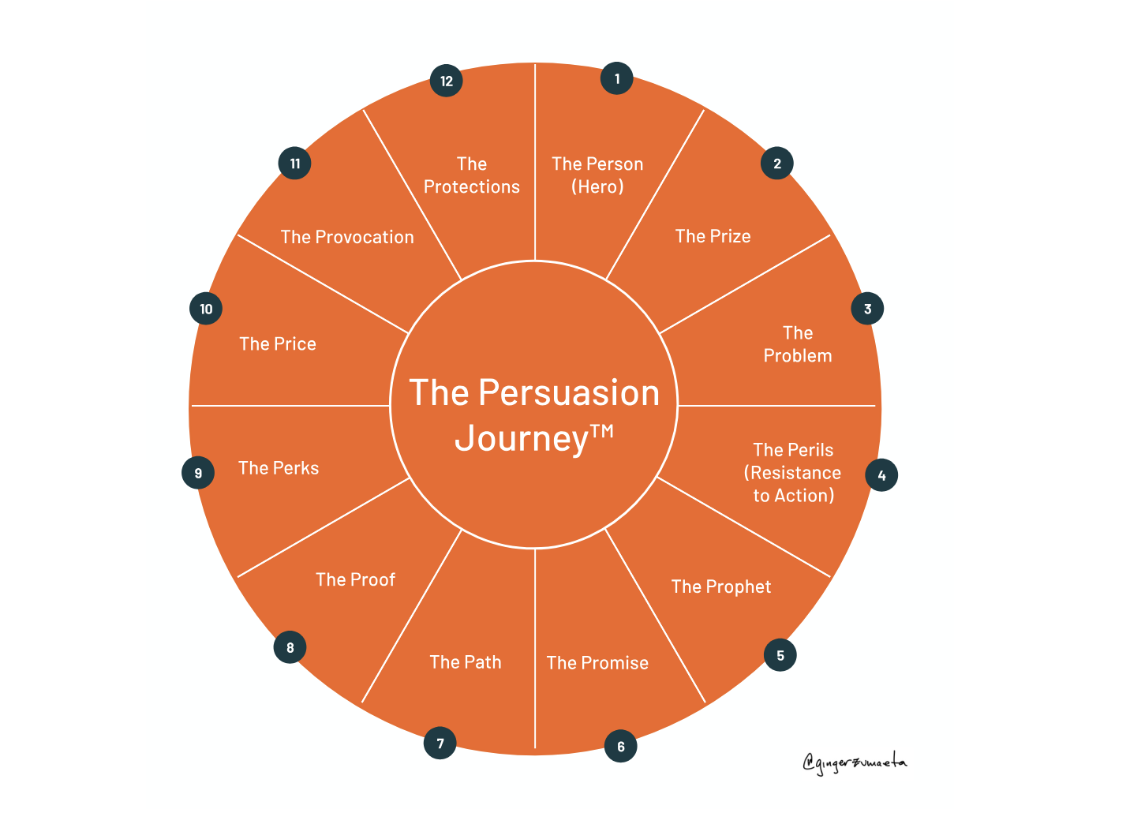"Harvard just discovered that PowerPoint is worse than useless. Intuitively, anecdotally, and scientifically, PowerPoint may be the worst business tool ever created."
That’s the title of an article published in Inc. in 2019.
Feels dramatic. But also… not wrong.
Slide after slide.
Bullets. Jargon. A timeline no one asked for.
You’re halfway through and still waiting for the point (which—side note—you’re starting to suspect isn’t coming).
Of course, the issue isn’t PowerPoint itself — it’s how we’ve been taught to use
it.
More slides + bullets = more proof = more conviction… right?
The result is usually the opposite.
The more information you add, the harder it becomes to see what matters. (I’ve seen brilliant teams talk themselves out of a yes by overloading the room.🫤)
And the cost of that is huge…..
$370 million is wasted daily on bad PowerPoint decks (Deckonomics®).
I’ve worked with teams burning 15+ hours a week reworking slides because the story never held together in the first place.
A deck is a tool.
Just like a mic, a stage, or AI.
(And like AI, it can amplify great thinking…or expose the lack of it.)
The most effective decks are built to do one thing: Make a decision easier.
And that doesn’t happen by accident.
There’s a structure underneath every high-stakes presentation that works. A specific sequence that guides the audience from problem to decision.
At Motive3, we call that structure: The Persuasion Journey™
It’s the framework we use to storyboard high-stakes presentations before a single slide is built.
Storyboarding with the 12Ps of the Persuasion Journey™
Before the slides, there’s the story.
Think of it like building a skyscraper. You wouldn’t start with drywall and hope it turns out okay. You’d sketch the whole plan first—foundation to rooftop—before touching a single brick.
Same with your slides. If the structure isn’t locked, your message won’t land.
Your deck should guide the audience toward a decision, not just deliver information!
When you structure your message like a story, and leverage decision-science, your audience is more likely to remember and act on it.
That’s where the 12Ps of the Persuasion Journey™ come in.
They’re the 12 building blocks that move your audience from uncertainty to conviction, by helping you map out:
- WHO you’re talking to
- WHAT they want
- WHY they should take action NOW
Here’s how the 12Ps play out in practice:
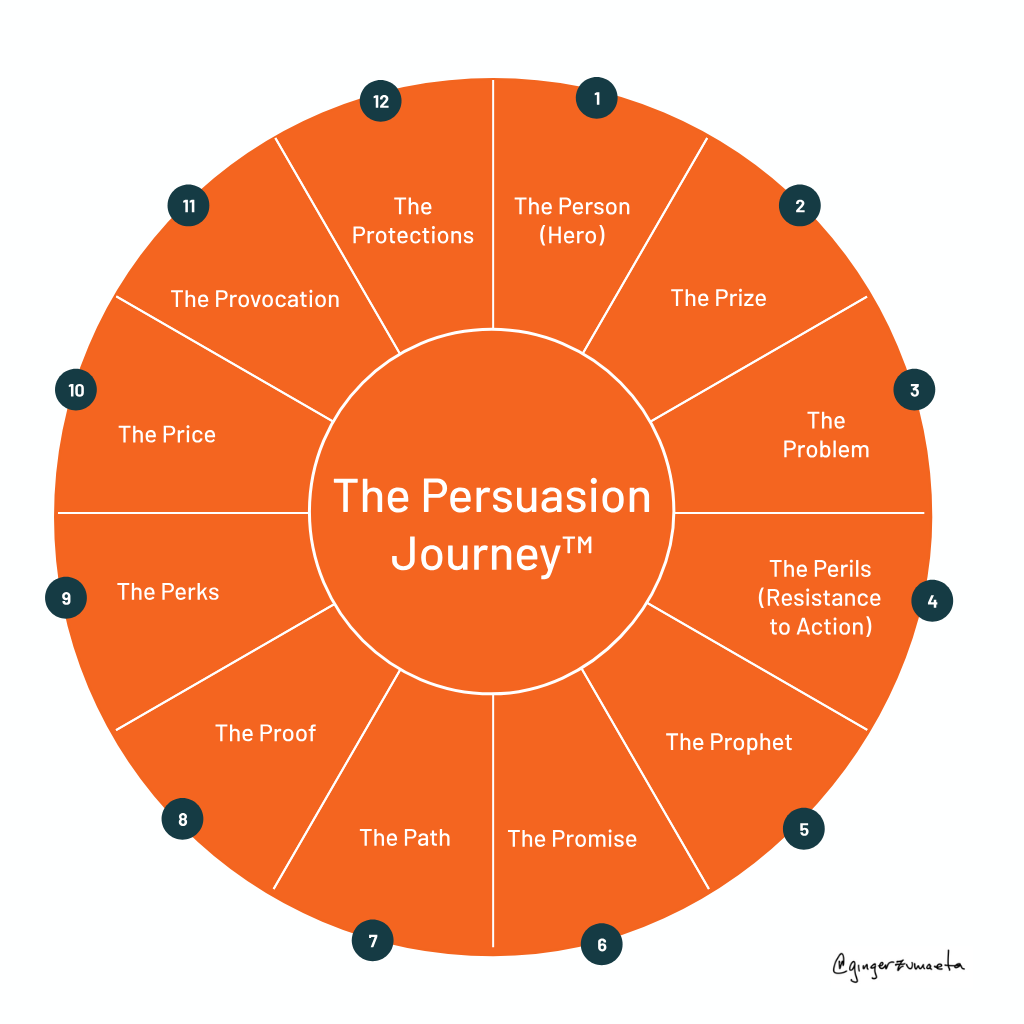
(For reference: the examples below all follow a single use case)
Ps 1–6: Define the Person, Problem & Conflict
Start by meeting your audience where they are.
This is your setup—-where you name the stakes, show you get their world, and make the tension real. The goal is to make the audience feel the friction of staying where they are.
1..Person – Who is the audience? (i.e Regional Logistics Managers)
2. Prize – What do they want? (i.e We need better on-time delivery across the region)
3. Problem – What’s standing in their way? (i.e. Our current scheduling process is completely manual)
4. Perils – What happens if they do nothing? (i.e We’re constantly overstaffing or missing delivery windows)
5. Prophet – Why should they trust YOU? (i.e. SHIFT has worked with leading carriers to fix this)
6. Promise – What’s the outcome you’re offering? (i.e. A dynamic scheduling engine to match workforce and capacity in real time)
P7: How to Solve the Problem
This is the turning point.
You’ve shown the pain. Now show the path. But keep it simple. This isn’t the demo, this is the clear, high-level bridge between problem and possibility.
7. Path – How do they get there? (i.e. Roll out SHIFT in three phases, starting with top-volume delivery hubs to build momentum and minimize risk)
Ps 8–12: Prove Why Action Is Necessary Now
This is your “why now” moment.
At this stage, your audience is already considering the leap. Your job is to remove friction and validate the logic.
8. Proof – Why should they believe you? (i.e. Other carriers using SHIFT cut delivery time by 42%)
9. Perks – What are the benefits? (i.e Overtime costs and fuel usage dropped by millions per quarter)
10. Price – What’s the cost of action vs. inaction? (i.e SHIFT implementation costs less than one missed SLA contract)
11. Provocation – What’s the final push? (i.e Every quarter we delay puts us further behind competitors already using automation)
12. Protections – How do you reduce their risk? (i.e SHIFT offers a 90-day pilot with full rollback support if it’s not a fit)
Once the 12Ps are mapped, you’ve got the story.
Now it’s time to make it visible.
Let’s look at how that story shows up on a slide—not in theory, but in the words, layout, and flow your audience actually sees.
Slide Anatomy: Before vs After
Here’s an example of a slide that simply delivers updates, followed by a version that applies the structure of the Persuasion Journey™.
Before
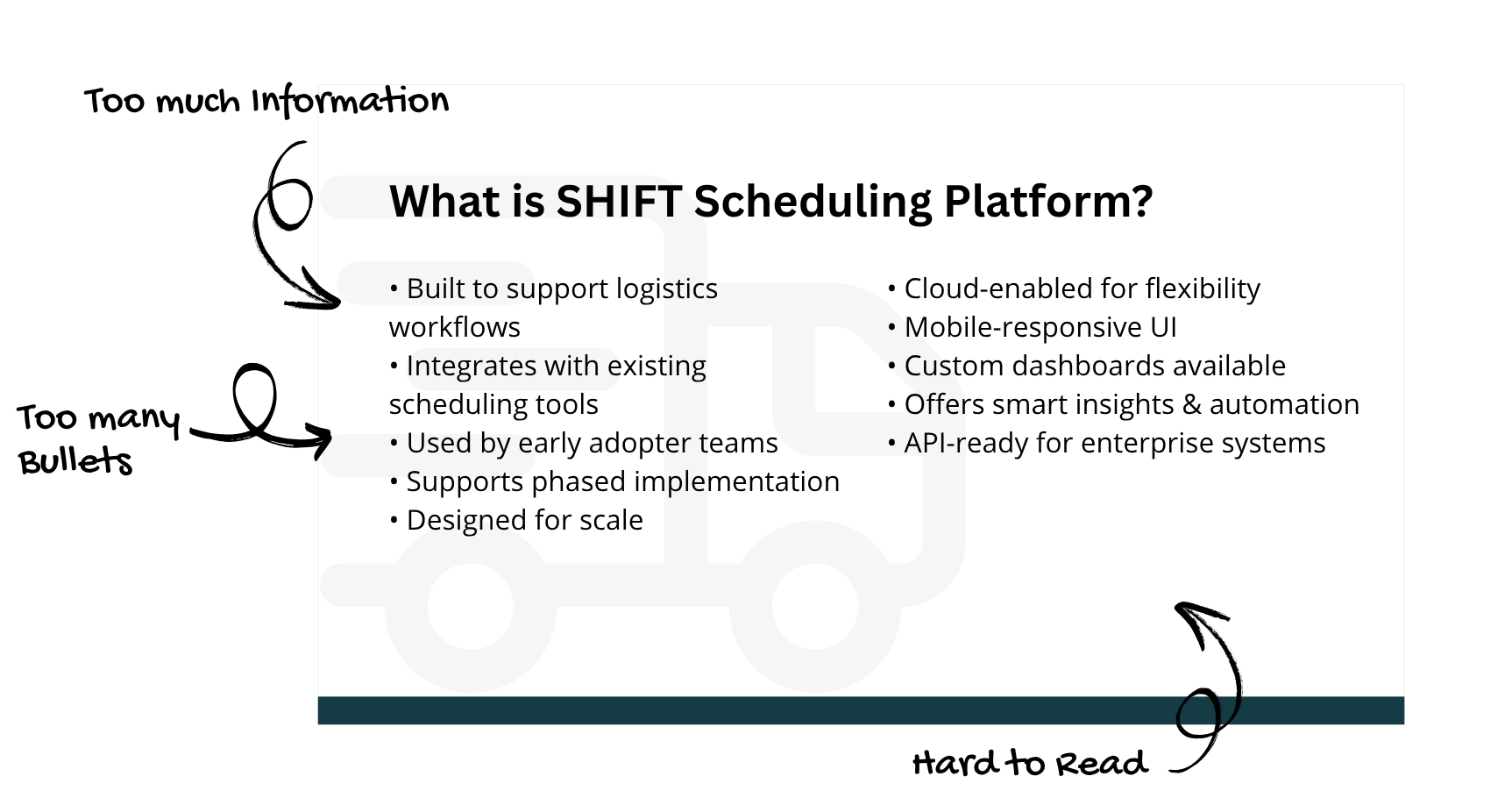
After
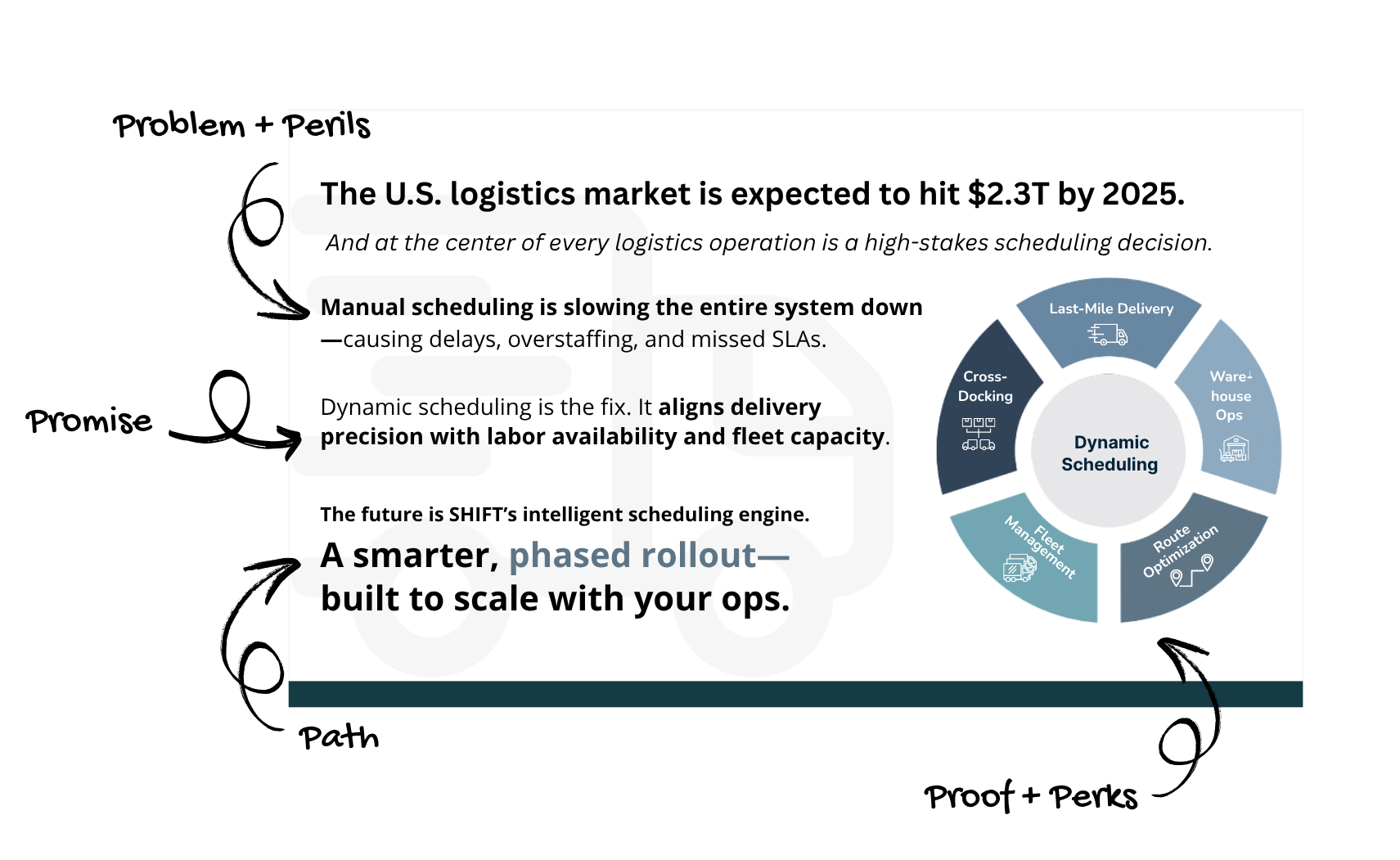
Action Step: Write One Sentence Per P
This is how you test if your story actually holds up (before you build a single slide).
📌 Grab sticky notes (or open a blank doc).
📌 Write one complete sentence per P.
📌 Use full thoughts—no bullet points.
Lay them out left to right like a storyboard:
P1–P6 → The situation
P7 → How to solve it
P8–P12 → Why to solve it now
When you can read it like a narrative, and it flows? You’ve got the spine of a persuasive deck.
Storyboard sticky note example:
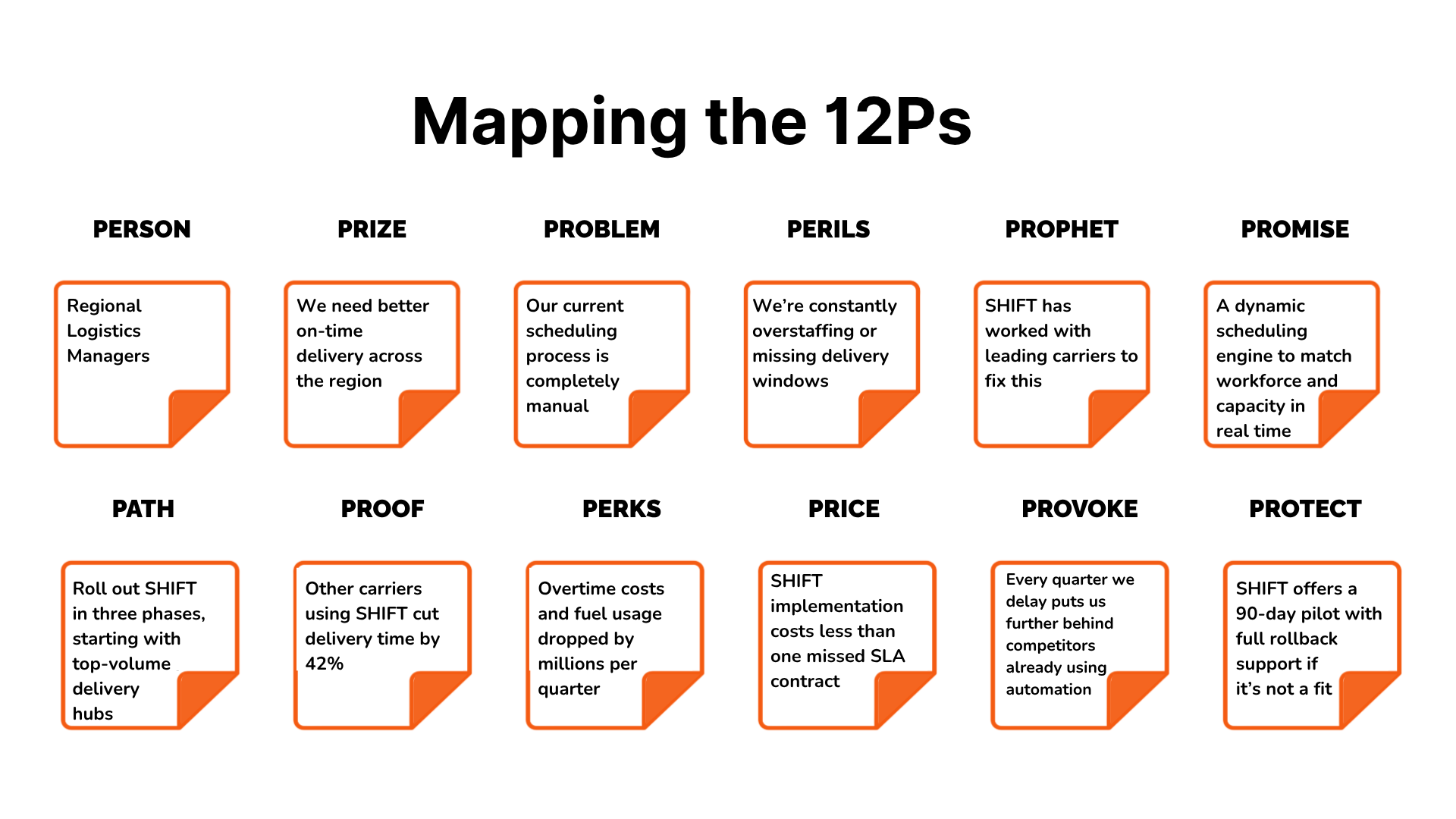
Bonus GPT Prompt:
Before you open PowerPoint, pressure-test the story behind your slides.
Paste in your 12-sentence story (one sentence per idea), and let GPT find the weak links before your audience does.
Prompt:
I’m working on a persuasive presentation. Below is a 12-sentence outline that represents the core story I’m planning to tell—one sentence per major idea.
[PASTE YOUR STORYBOARD SENTENCES HERE]
Please analyze this and answer:
- Where does the story start to lose momentum?
- What part would make a skeptical audience hesitate?
- Is the Path to solving the problem clear and believable—or too vague?
- Where do I accidentally sound like I’m trying to justify instead of persuade?
- Which sentence sounds good but doesn’t actually move the story forward?
- What’s missing that would make this feel like a no-brainer decision?
One last step before you're done.
Pick one slide from your deck.
Now play detective:
Figure out which “P” it’s trying to cover. (Just find one. Not all twelve.)
If you can’t tell… refocus the slide to do one job and one job only.
If you want more, Deckonomics® is the step-by-step blueprint behind everything you just read. Check it out.




